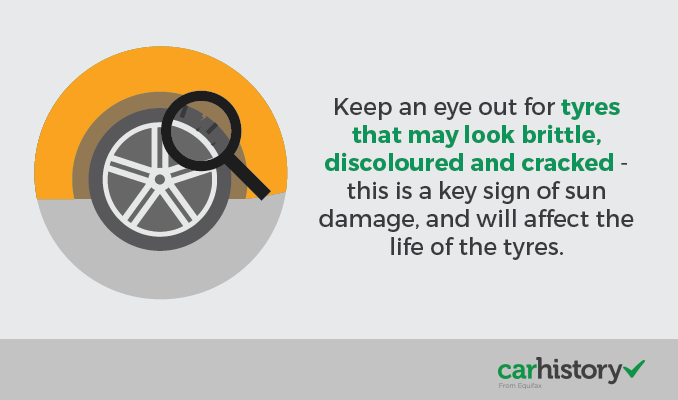
The vehicle identification number (VIN) is composed of 17 characters (digits and capital letters) that act as a unique identifier for the vehicle. A VIN displays the car's unique features, specifications and manufacturer.
The VIN can be found in a couple of places including on the car's registration label (1), on the compliance plate in the engine bay (2) or on the passenger side windshield (3), or on one of the door posts (where the door latches when it is closed) (4). See the image below:
We've stressed time and time again about the importance of inspecting a used car very thoroughly before you decide to buy. However, one important feature that is commonly missed are tyres.
They're what helps to deliver you to your destination safely, and can affect driving experience as well as fuel consumption.
Don't neglect this crucial part of your buying process. Learn how to determine the state of a second-hand car's tyres.
Feeling tyre'd?
If you don't know much about vehicles, use the condition of tyres as an indication of the car's suitability. Make sure all of them match in size and are in a clean condition. It doesn't take much effort to clean your tyres and if they're in a poor state, it's a possible indication of how its past owner has treated the whole car.
This saves time when first perusing a range of second-hand cars. If the tyres don't look any good, you may not want to consider it, or perhaps you can use it as a bargaining tool.
Getting your hands dirty
You'll have to physically handle the tires to determine exactly what condition they are in. It may require you to bend low to the ground, and you will get your hands dirty.
Tyres wear out - it happens gradually through driving. Eventually, they will deteriorate so much that it isn't fit for the roads, so looking at the tread depths and wear patterns are vital.
With you palm, run it over the tyre in all directions. Any unevenness in the wear of the tyres should literally jump out under the flat of your hand.
If you notice wear on the outside of both two front or back tyres, then it's a sign that the wheel alignment could be off. Any other lumps and bumps could point to a need to change tyres.

Treading deep
Tread depth is important because your tyres need to grip the road for traction. Too bald, and skidding is highly likely to occur under certain circumstances. The space in a tread is used to pump water out in rainy conditions so that you can drive safely1.
The RACQ requires that tyres maintain a minimum tread depth of 1.5 mm. It explains that there are tread indicators marked at regular intervals across the circumference of your tyre to help you gauge the extent of wear2.
Keep an eye out for tyres that may look brittle, discoloured and cracked - this is a key sign of sun damage, and will affect the life of the tyres.
To be extra sure a used car is worth your money, get a CarHistory report first.
1Toyo Tires Australia, Tyre Safety. Accessed March 2016.